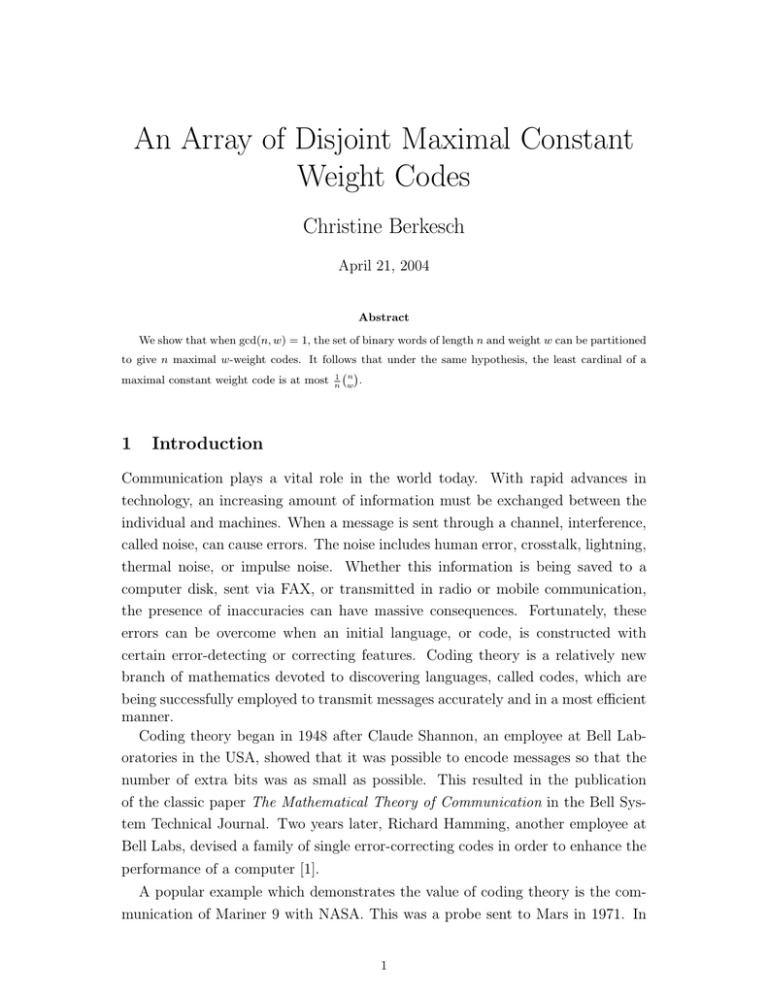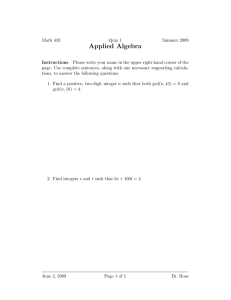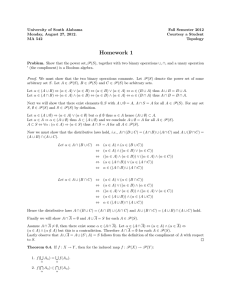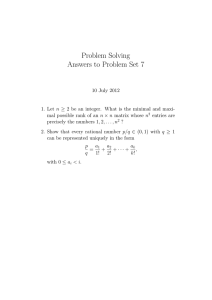An Array of Disjoint Maximal Constant Weight Codes Christine Berkesch 1
advertisement

An Array of Disjoint Maximal Constant
Weight Codes
Christine Berkesch
April 21, 2004
Abstract
We show that when gcd(n, w) = 1, the set of binary words of length n and weight w can be partitioned
to give n maximal w-weight codes. It follows that under the same hypothesis, the least cardinal of a
`n´
maximal constant weight code is at most n1 w
.
1
Introduction
Communication plays a vital role in the world today. With rapid advances in
technology, an increasing amount of information must be exchanged between the
individual and machines. When a message is sent through a channel, interference,
called noise, can cause errors. The noise includes human error, crosstalk, lightning,
thermal noise, or impulse noise. Whether this information is being saved to a
computer disk, sent via FAX, or transmitted in radio or mobile communication,
the presence of inaccuracies can have massive consequences. Fortunately, these
errors can be overcome when an initial language, or code, is constructed with
certain error-detecting or correcting features. Coding theory is a relatively new
branch of mathematics devoted to discovering languages, called codes, which are
being successfully employed to transmit messages accurately and in a most efficient
manner.
Coding theory began in 1948 after Claude Shannon, an employee at Bell Laboratories in the USA, showed that it was possible to encode messages so that the
number of extra bits was as small as possible. This resulted in the publication
of the classic paper The Mathematical Theory of Communication in the Bell System Technical Journal. Two years later, Richard Hamming, another employee at
Bell Labs, devised a family of single error-correcting codes in order to enhance the
performance of a computer [1].
A popular example which demonstrates the value of coding theory is the communication of Mariner 9 with NASA. This was a probe sent to Mars in 1971. In
1
order to transmit gray-scale pictures of that planet, individual pixels were sent on
a scale from 0 to 63. To send these numbers, NASA implemented a Reed-Muller
code capable of correcting up to 7 errors in a single 32-bit word (consisting of 6
data bits and 26 check bits). Mariner 9 was able to transmit over 16,000 bits per
second back to Earth.
An everyday example of error-correcting codes can be found in the compact
disc. On CDs, the signal is encoded digitally. To prevent skips from scratches,
two “interleaved” codes are used which can correct up to 4,000 consecutive errors
(about 2.5 mm of track) [4].
2
Definitions
Let F2 denote the finite field of order 2, and Fn2 the n-dimensional vector space over
F2 . The elements of Fn2 are called binary words of length n. The weight of a word
x = (x1 , x2 , . . . , xn ), denoted ||x||, is defined to be |{i : xi = 0}|. The Hamming
distance H between words x and y ∈ Fn2 is the number of positions in which they
differ. In other words
H(x, y) := |{i : 1 ≤ i ≤ n, xi = yi }| = ||x − y||.
A non-empty subset C of Fn2 is called a binary code, and the elements of C
are binary codewords. C is called an (n, d) binary code if d ≤ H(x, y) for all
x, y ∈ C, x = y. The minimum distance in a code C is defined to be min{H(x, y) :
x, y ∈ C, x = y}.
The codewords of length n in a binary code are sometimes referred to as n-bit
codewords. When dealing with such codes, 0 and 1 denote the n-bit words of all
0’s and 1’s, respectively.
Let P be a property of binary codes. A code C is said to be maximal P provided
C has P and no code having P properly contains C. A code C is optimal P provided
C has property P and for any code D having P , |D| ≤ |C|.
Let X denote the set {1, 2, 3, . . . , n}, and P (X) the power set of X. The function
r : Fn2 → P (X), defined by r(x) = {i : xi = 1} is a one-to-one correspondence
between Fn2 and P (X). Thus, each binary word of length n will be identified with
a subset of X. Let X
denote the set of subsets associated with binary words of
w
weight w.
For two sets A and B, their symmetric difference is A B := (A − B) ∪ (B − A).
Observe that H(x, y) = |r(x) r(y)|.
2
3
Constant Weight Binary Codes
An (n, d) code C is said to have constant weight w, and is called an (n, d, w) code,
if every word in C has weight w. A(n, d) and A(n, d, w) respectively denote the
cardinality of an optimal (n, d) and an optimal (n, d, w) code. Similarly, a(n, d) and
a(n, d, w) respectively denote the least possible cardinality of a maximal (n, d) code
and a maximal (n, d, w) code. In general, the values of all four of these functions
are unknown.
In an exhaustive study of the lower bounds for A(n, d, w), A. E. Brouwer, et al.
[2] found an elegant method to partition the set of binary words of length n and
weight w into n (n, 4, w) codes, thus proving that A(n, 4, w) ≥ n1 wn . The purpose
of this paper is to show that if gcd(n, w) = 1, then each of the n codes defined in
[2] is, in fact, maximal (n, 4, w). Before proving this result, we first briefly sketch
the construction given in [2].
Theorem 1. A(n, 4, w) ≥
1 n
n w
Proof. Let Zn be the group of integers modulo n, and consider the function
→ Zn , defined by f (A) = ( a∈A a) (mod n). For an i, 0 ≤ i ≤ n − 1,
f : X
w
let Ci = f −1 (i). Let A, B ∈ Ci , A = B. We will show that |A B| ≥ 4. Clearly
|A B| = 2w − 2|A ∩ B|, a positive even integer. Now if |A B| = 2, then there
exist a0 ∈ A and b0 ∈ B such that A B = {a0 , b0 }. Since a∈A a = b∈B b = i
(mod n), we have that a0 = b0 (mod n). But that is impossible because a0 = b0
and both a0 and b0 belong to the set X = {1, 2, . . . , n}. It follows that |AB| ≥ 4;
thus, each Ci is an (n, 4, w) code. As the collection {C0 , C1 , . . . , Cn−1 } is obviously
a partition of X
and | X
| = wn , therefore some Ci must have at least n1 wn
w
w
elements. 2
Theorem 2. If 2 ≤ w < n and gcd(n, w) = 1, then
X w
can be partitioned into n
maximal (n, 4, w) codes.
Proof. We will prove that under the given hypothesis, each of the sets Ci , 0 ≤
i ≤ n − 1, defined in the proof of Theorem 1 is a maximal (n, 4, w) code. We
do this by showing that for each i and for any A ∈ X
, if A ∈
/ Ci , then there is
w
a B ∈ Ci such that H(A, B) = 2. Fix an i and an A, as stated. Determine j,
/ Ci ,
0 ≤ j ≤ n − 1, such that A ∈ Cj and then let k = (i − j)(mod n). As A ∈
j = i, and thus 0 < k < n. For each a ∈ A, let a∗ = (a + k)(mod n). If for some
/ A, then by deleting a0 from A and inserting a∗0 in its place, we obtain
a0 ∈ A, a∗0 ∈
3
a set B as desired. To see why, note that A B = {a0 , a∗0 }, and so |A B| = 2.
Also, summing modulo n, we have b∈B b = a ∈ A + a∗0 − a0 = j + k = i. Thus,
B ∈ Ci .
To complete the proof, we show that under the given hypothesis, there exists
an a ∈ A for which a∗ ∈
/ A. By way of contradiction, suppose such an a does not
exist. Let k
be the subgroup of Zn generated by k. Then for each a ∈ A, the
coset k
+ a is contained in A. Therefore, A is a union of a set of cosets of k
in Zn . As the order of the subgroup k
is
n
g
where g = gcd(k, n), it follows that
the cardinality of A, namely w, is a multiple of ng . This, in view of the hypothesis
that gcd(n, w) = 1 implies that
n
g
= 1, so n = gcd(n, k). But then k ≥ n, a
contradiction. 2
Corollary. If gcd(n, w) = 1, then a(n, d, w) ≤
1 n
n w
.
The proof of Theorem 2 implies that if gcd(n, w) = g > 1, then at least one of
the Ci is not a maximal (n, 4, w) code. To see this, let w = gw1 and n = gn1 , and
note that the subgroup n1 of Zn is of order g. Choose any w1 of the cosets of n1 . Then, for each a ∈ A, (a + n1 )
in Zn , and let A be their union, so that A ∈ X
w
/ Ci even though
(mod n) ∈ A. Thus, if A ∈ Cj and if i = (j +n1 ) (mod n), then A ∈
A is at a distance at least 4 from each member of Ci , as shown in the proof of Theorem 1. Thus, Ci is not a maximal (n, 4, w) code, and we have shown the following.
Theorem 3. If gcd(n, w) > 1, then at least one Ci is not a maximal (n, 4, w) code.
An interesting interpretation of Theorem 2 in terms of “graph-coloring” is as
follows: If gcd(n, w) = 1, it is possible to color each binary word of length n and
weight w in one of n given colors so that each of the monochromatic classes is a
maximal (n, 4, w) code. It is noteworthy that similar “color” partitions into optimal
codes do not always exist. This is due to the fact that A(n, d) and A(n, d, w)
generally fail to divide 2n and wn , respectively. For example, A(9, 4) = 40 which
does not divide 29 , so a monochromatic partition of F92 into optimal (9, 4) codes
does not exist. Similarly, A(11, 4, 4) = 35, which does not divide 11
, so the set
4
of binary words with length 11 and weight 4 cannot be partitioned into optimal
(11, 4, 4) codes.
Acknowledgements. This research was done during Summer 2003 at Butler
University under the guidance of Dr. Prem Sharma as a part of the Butler Summer
Institute, funded by a Holcomb Undergraduate Grant.
4
References
[1] A History of Fundamental Mathematics Research at Bell Labs (1998).
(http://cm.bell-labs.com/cm/ms/departments/fm/history.html)
[2] A. E. Brouwer, James B. Shearer, N. J. A. Sloane, and Warren D. Smith,
A New Table of Constant Weight Codes, IEEE Transactions on Information
Theory, Vol. 36, No. 6, November 1990.
[3] J. H. van Lint, Introduction to Coding Theory, 3rd Edition, Springer-Verlag,
Berlin 1999.
[4] Richard Pinch, Coding theory: the first 50 years, PASS Maths, Issue No. 3:
September 1997. (http://plus.maths.org/issue3/codes/index.html)
[5] E. M. Rains and N. J. A. Sloane, Table of Constant Weight Binary Codes.
(http://www.research.att.com/ njas/codes/Andw/)
5





